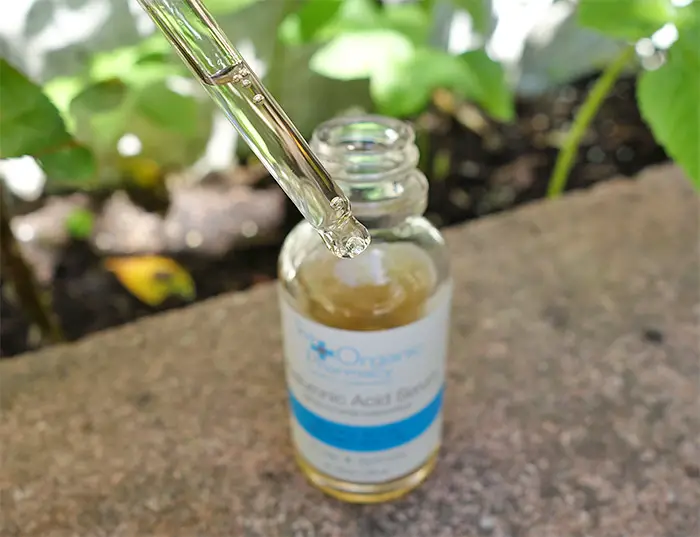
If you have perioral dermatitis, you might be wondering if hyaluronic acid is good for your skin. Hyaluronic acid is known for its ability to hydrate and support the skin’s barrier, making it a popular ingredient in many skincare products. While it is generally safe to use and can be helpful for those with perioral dermatitis, it’s important to note that studies specifically focusing on hyaluronic acid’s effects on this condition are lacking.
In this article, we’ll explore how hyaluronic acid might benefit those with perioral dermatitis, discuss its safety, and offer guidance on how to use it effectively. We’ll also look into whether there are any risks associated with using hyaluronic acid when you have this condition.
Whether you’re considering adding hyaluronic acid to your skincare routine or just curious about its effects, this guide will provide you with the information you need to make an informed decision.
Table of Contents
- What is Hyaluronic Acid?
- How Hyaluronic Acid Helps With Dermatitis
- Safety of Hyaluronic Acid for Perioral Dermatitis
- Can Hyaluronic Acid Cause Perioral Dermatitis?
- Using Hyaluronic Acid with Perioral Dermatitis
- Conclusion
What is Hyaluronic Acid?
Hyaluronic acid is a substance that naturally occurs in our skin and helps it stay hydrated. It’s a favourite ingredient in many skincare products because it holds onto water, helping to keep the skin moisturized. This makes hyaluronic acid perfect for use in lotions and serums.
Aside from keeping the skin hydrated, hyaluronic acid is great for strengthening the skin’s barrier. This means it helps keep harmful irritants out, which can be really beneficial for people dealing with conditions like perioral dermatitis. This barrier protection can ease symptoms like redness and itching.
Moreover, hyaluronic acid is also known for its healing properties. It can help the skin heal faster by controlling inflammation and signaling the body to build more blood vessels in the damaged area. This is especially helpful in treating dry or damaged skin, making hyaluronic acid not just a moisturizer but also a supporter of skin repair.
How Hyaluronic Acid Helps With Dermatitis
Hyaluronic acid is gaining attention not just for its hydrating properties but also for its role in managing dermatitis, a group of skin conditions that includes perioral dermatitis. The compound’s ability to soothe inflammation and repair the skin barrier makes it a valuable tool for those with sensitive skin conditions.
Research Insights:
A study published in the National Library of Medicine (link here) looked at the use of hyaluronic acid sodium salt gel 0.2% for treating facial seborrheic dermatitis. The results were promising, showing improvement in skin conditions such as scaling, redness, itching, and overall disease appearance after regular application. This improvement was sustained over several weeks, highlighting hyaluronic acid’s potential for long-term benefits.
Wider Benefits for Skin Conditions:
A comprehensive review found in ScienceDirect (link here) discusses hyaluronic acid’s efficacy across various inflammatory skin conditions. It points out that hyaluronic acid can help in regenerating damaged skin tissues, reducing inflammation, and enhancing skin’s viscoelasticity and hydration. This makes it an excellent candidate for treating conditions similar to perioral dermatitis.
What This Means for Perioral Dermatitis
These studies suggest that while more targeted research is needed, hyaluronic acid has a beneficial role in treating inflammatory skin diseases by reducing symptoms and aiding in skin recovery. This is particularly relevant for perioral dermatitis, where maintaining skin hydration and barrier function is crucial for managing the condition.
In summary, while direct research on hyaluronic acid and perioral dermatitis specifically is sparse, existing studies on similar skin conditions provide a strong basis for considering hyaluronic acid as a helpful component in managing dermatitis symptoms effectively.
Safety of Hyaluronic Acid for Perioral Dermatitis
Is Hyaluronic Acid Safe for Sensitive Skin?
When it comes to managing perioral dermatitis, safety is just as important as effectiveness. Hyaluronic acid is generally known for its gentle nature and good safety profile, which makes it a preferred choice for those with sensitive skin conditions. Because it is a substance naturally found in the body, it typically does not provoke allergic reactions or irritate the skin.
Dermatologists often recommend hyaluronic acid to help with perioral dermatitis due to its ability to hydrate and strengthen the skin’s barrier. This hydration is essential for alleviating the dryness and irritation associated with the condition. Additionally, reinforcing the skin’s barrier helps protect against external factors that could aggravate symptoms.
However, it’s important to approach new skincare products with caution, even those as generally safe as hyaluronic acid. Starting with a small amount of product can help you determine how your skin reacts. If you notice any irritation, it’s best to stop using the product and consult with a dermatologist. This step is important because perioral dermatitis can be sensitive to various ingredients, and what works for most might not work for you.
Can Hyaluronic Acid Cause Perioral Dermatitis?
One of the key questions for anyone considering hyaluronic acid for perioral dermatitis is whether it could potentially cause the condition to flare up. Generally, hyaluronic acid is considered safe and is not known to cause perioral dermatitis. Due to its natural presence in the human body and its role in maintaining skin hydration and barrier function, it is typically well-tolerated and does not trigger the condition.
However, like any skincare ingredient, there is always a chance of sensitivity or a negative reaction, particularly in individuals with very sensitive or reactive skin. It’s possible, though rare, for someone to experience irritation from hyaluronic acid, especially if used in high concentrations or in formulations that contain other potential irritants.
Known Irritants to Avoid:
For those with perioral dermatitis, it is crucial to avoid ingredients that are known to cause irritation. Some common irritants include alcohol, witch hazel, menthol, camphor, and fragrances. These ingredients can dry out the skin or cause irritation, leading to flare-ups. Additionally, harsh exfoliants and some essential oils should also be used with caution, as they can be too abrasive or stimulating for sensitive skin areas affected by dermatitis.
Safe Skincare Practices:
When introducing any new product, including those containing hyaluronic acid, it’s a good practice to perform a patch test on a small area of skin before applying it to your face. This can help identify any adverse reactions in a controlled way. Consulting with a dermatologist before adding new products to your skincare routine can also provide guidance tailored to your specific skin needs, helping to minimize the risk of irritation and flare-ups.
Using Hyaluronic Acid with Perioral Dermatitis
If you’re considering hyaluronic acid for managing perioral dermatitis, it’s important to introduce it carefully into your skincare regimen to ensure it benefits your skin without causing irritation.
Choosing the Right Product:
Opt for products that are specifically formulated for sensitive or compromised skin. Serums and creams with hyaluronic acid that are free from potential irritants like fragrances, alcohols, and harsh chemicals are ideal. These formulations are usually lighter and more gentle, making them suitable for delicate skin areas affected by dermatitis.

How to Apply Hyaluronic Acid Products:
- Start Slowly: Begin by applying a small amount of hyaluronic acid product every other day to see how your skin responds. If your skin tolerates it well without any signs of irritation, you can gradually increase to daily use.
- Layer Properly: Apply hyaluronic acid products to damp skin for the best results. This helps to lock in moisture and maximizes the hydrating effects. After applying hyaluronic acid, follow up with a gentle moisturizer to further protect the skin barrier.
- Monitor Your Skin’s Response: Keep an eye on how your skin reacts over the first few weeks. If you notice any redness, itching, or discomfort, reduce the frequency of application or discontinue use and consult with a dermatologist.
Recommended Types of Products:
- Serums: Hyaluronic acid serums are typically lightweight and highly effective at penetrating the skin to deliver deep hydration.
- Creams: Look for creams that combine hyaluronic acid with other soothing ingredients like ceramides or aloe vera, which can help calm irritation and reinforce the skin’s natural barrier.
General Advice:
Always check the ingredient list to ensure that the product is suitable for sensitive skin and free from common irritants. Remember, a simpler product with fewer ingredients is often a safer choice for skin prone to dermatitis.
Conclusion
Hyaluronic acid is generally safe and beneficial for those with perioral dermatitis due to its hydrating properties and ability to strengthen the skin’s barrier. However, it’s important to choose the right products and incorporate them safely into your skincare routine. Since individual reactions can vary, it’s important to consult with a dermatologist before making any changes. Hyaluronic acid could be a valuable addition to your routine, helping to manage symptoms and improve skin health.

Petra Nakashian (previously Kravos) is a dedicated natural health and beauty blogger, driven by the loss of her parents to cancer, which led her to meticulously research beauty product ingredients. With over 10 years of experience, her in-depth knowledge has made her a trusted expert in the field. Founder of Be Healthy Now and Green Beauty Talk, Petra recently expanded her expertise with Beauty Insights Hub, exploring a wider range of beauty treatments. Committed to transparency and honesty, her work is a vital resource for navigating the complex world of beauty.

